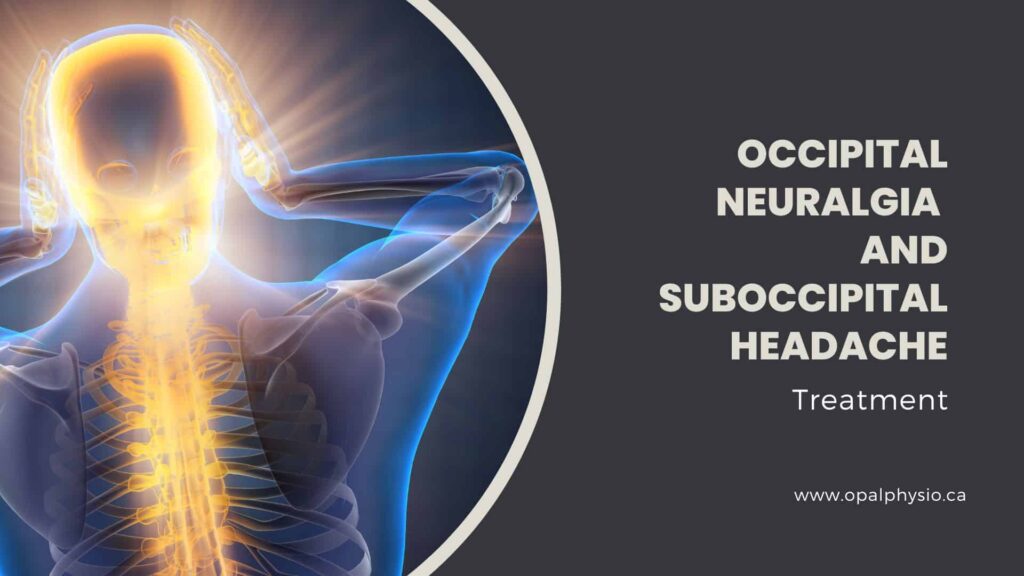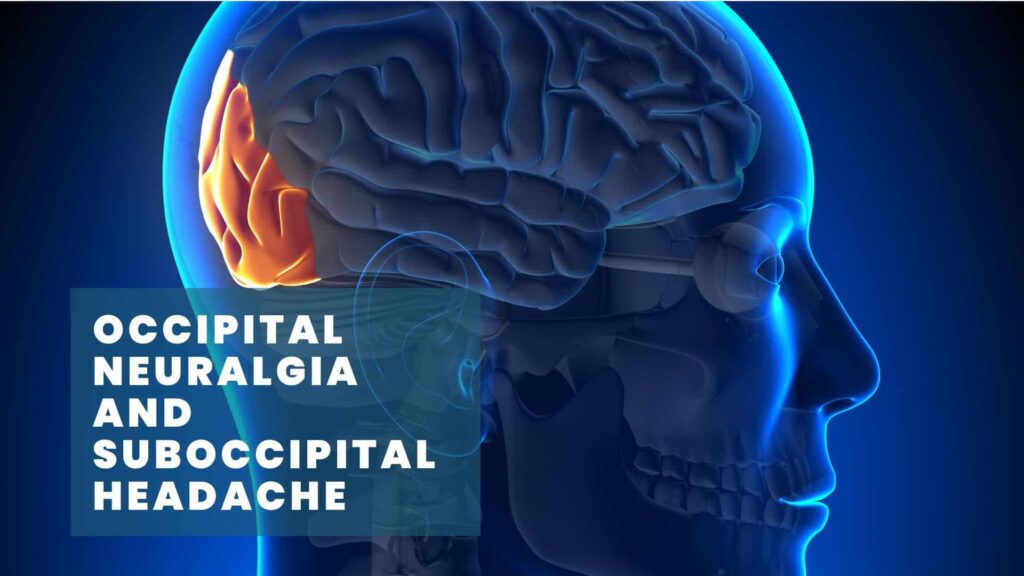Occipital Neuralgia | Suboccipital Headache
Are you experiencing persistent pain in your upper neck or back of the head? You might have occipital neuralgia.
Occipital neuralgia and suboccipital headache are debilitating conditions that can significantly impact quality of life. They cause intense pain in the head, neck, and scalp regions. These neurological disorders stem from irritation or compression of the occipital nerves, which run from the top of the spinal cord to the scalp.
While these conditions can be challenging to diagnose and treat, physiotherapy offers a non-invasive, effective approach to managing symptoms and improving overall function. Our specialized physiotherapy services focus on addressing the underlying causes of nerve irritation, reducing pain, and enhancing mobility in the affected areas.

Suboccipital headache occipital neuralgia treatment in Langley
Our Opal Physiotherapy and Health Clinic offers specialized treatment for occipital neuralgia and suboccipital headache, two related conditions in the head and neck region. Our expert physiotherapists are trained to diagnose and treat these conditions using a range of evidence-based techniques and interventions.
Understanding occipital neuralgia and suboccipital headaches
Occipital neuralgia typically presents as a distinct headache with sharp, shooting pain that starts at the base of the skull and radiates upward to the head, often described as an electric shock-like sensation. This condition results from irritation or injury to the occipital nerves, which run from the top of the spinal cord to the scalp.
Suboccipital headache, which is closely related, originates in the suboccipital region, which is the area at the base of the skull where the neck meets the head. Pain may radiate to other areas, including the top of the head, behind the eyes, or the shoulders. It is typically described as a deep, aching pain and is often associated with tightness or tension in the neck muscles.
Causes of occipital neuralgia
Some causes include
- Pinched nerves in the neck
- Muscle tightness in the neck and back of the head
- Injury to the head or neck (e.g., whiplash)
- Osteoarthritis of the upper cervical spine
- Cervical disc disease
- Compression of the greater and/or lesser occipital nerves
- Tumours affecting the C2 and C3 nerve roots
- Diabetes
- Gout
- Blood vessel inflammation
- Infection
- Trauma to the greater and/or lesser occipital nerves
- Degenerative changes in the cervical spine
Causes of suboccipital headache
Suboccipital headache is often considered a subset of occipital neuralgia. The causes are similar but with a focus on the suboccipital region:
- Muscle tension in the suboccipital muscles at the base of the skull.
- Prolonged poor posture, especially when sitting at a computer for long periods, can lead to muscle tension and suboccipital headaches.
- Problems with the upper cervical spine, such as arthritis or degenerative changes, can contribute to suboccipital headaches.
- Irritation or compression of the occipital nerves can cause pain in the suboccipital region.
- Whiplash or other neck injuries can lead to suboccipital headaches.
- Activities that involve prolonged neck extension, such as cycling or certain work positions, can overwork the suboccipital muscles.
- Emotional stress can cause muscle tension in the neck and suboccipital region, leading to headaches.
- Upper cervical instability irritates the nerves and muscles in the suboccipital area.
It’s important to note that the exact cause of occipital neuralgia or suboccipital headache may not be determined in many cases. Additionally, these conditions can sometimes occur spontaneously without a clear underlying cause. If you’re experiencing symptoms of either condition, it’s crucial to consult with a healthcare professional for an accurate diagnosis and appropriate treatment plan.
Symptoms and diagnosis
Our physiotherapists are skilled in recognizing the unique symptoms of occipital neuralgia, which can include:
- Sharp, shooting, or electric-shock-like pain in the upper neck and back of the head
- Pain that radiates towards the scalp, forehead, or behind the eyes
- Tenderness and sensitivity in the affected areas
- Pain triggered by neck movements or pressure on the affected area
- Aching, burning, or throbbing pain that may be constant or intermittent
Diagnosis involves a thorough physical examination, including palpation of the affected areas and neck mobility and strength assessment.
Proper diagnosis by a healthcare professional is crucial for effective treatment. Management often involves addressing the underlying causes, such as improving posture, reducing muscle tension through stretching and massage, and addressing any cervical spine or nerve issues.

Our specialized physiotherapy approach
Our clinic offers a comprehensive treatment approach for occipital neuralgia and suboccipital headaches tailored to each patient’s specific needs and symptoms.
1. Manual therapy techniques
Our physiotherapists employ various hands-on techniques to alleviate pain and improve function:
- Soft tissue mobilization: Gentle massage and manipulation of the neck and scalp muscles to reduce tension and improve blood flow.
- Joint mobilization: Careful mobilization of the cervical spine joints to improve mobility and reduce nerve irritation.
- Myofascial release: Targeting the fascia (connective tissue) to release tension and improve flexibility.
2. Therapeutic exercises
We design personalized exercise programs to strengthen and stretch the neck and upper back muscles, improving posture and reducing nerve compression:
- Gentle neck stretches to improve flexibility and reduce muscle tension.
- Strengthening exercises to improve neck and upper back strength, supporting better posture.
- Postural correction exercises focused on improving overall posture to reduce strain on the occipital and suboccipital regions.
3. Neuromobilization techniques
These specialized techniques aim to improve nerve mobility and reduce irritation:
- Nerve gliding or flossing exercises: Gentle movements designed to mobilize the occipital and cervical nerves and reduce adhesions.
4. Pain management modalities
We utilize various modalities to manage pain and promote healing:
- Heat therapy: Application of heat to relax muscles and improve blood flow.
- Cold therapy: Use of cold packs to reduce inflammation and reduce pain.
- Transcutaneous electrical nerve stimulation (TENS): Electrical stimulation disrupts pain signals and promotes pain relief.
- Ultrasound Therapy: Deep heating of tissues to promote healing and reduce pain.
- Low-level laser therapy to reduce any inflammation and pain
5. Postural education and ergonomic advice
Our physiotherapists provide comprehensive education on:
- Proper posture for various activities (sitting, standing and sleeping postures)
- Ergonomic adjustments for work and home environments
- Techniques to reduce strain on the neck and upper back during daily activities
6. Trigger point therapy
For patients with specific tender points contributing to their pain:
- Dry needling: Insertion of thin needles into trigger points to release muscle tension.
- Manual trigger point release: Direct pressure and manipulation of trigger points to alleviate pain and tension.
7. Lifestyle and self-management strategies
We empower our patients with strategies to manage their condition at home:
- Self-massage techniques: Teaching patients how to perform gentle self-massage to alleviate tension.
- Stress management: Techniques to reduce overall stress that can exacerbate neuralgia symptoms.
- Sleep hygiene: Advice on optimal sleeping positions and pillow use to reduce strain on the neck.
Advanced treatment options
For complex cases that require additional intervention, we work closely with medical specialists who can offer
- Nerve blocks: Local anesthetic injection near the affected nerves to provide temporary relief and aid diagnosis.
- Botulinum toxin injections: In some cases, Botox injections may be recommended to reduce muscle tension and nerve irritation.
- Trigger point injections
Please note that you require a referral from your physician to access the specialist services at our clinic.
Our multidisciplinary approach
We believe in a holistic approach to treating occipital neuralgia and suboccipital headache. Our physiotherapists collaborate with other healthcare professionals, including pain management specialists and massage therapists.
This multidisciplinary approach ensures comprehensive care and the best possible outcomes for our patients.

Treatment duration and expectations
The duration of treatment for occipital neuralgia and suboccipital headache can vary depending on the severity of the condition and individual patient factors. Typically, patients may see improvement within 6-8 weeks of consistent treatment. However, some cases may require long-term management.
Our physiotherapists will regularly assess your progress and adjust your treatment plan as needed. We aim to not only alleviate your current symptoms but also provide you with the tools and knowledge to prevent future recurrences.
Why choose our clinic?
- Expertise: Our physiotherapists have training in treating head and neck conditions.
- Personalized care: We develop individualized treatment plans tailored to each patient’s specific needs and goals.
- State-of-the-art facilities: Our clinic is equipped with the latest physiotherapy equipment and technologies.
- Evidence-based practice: We stay up-to-date with the latest research and incorporate evidence-based techniques into our treatments.
- Patient education: We believe in empowering our patients with knowledge about their condition and self-management strategies.
Getting started with occipital neuralgia treatment in Langley
Whether you’re seeking to complement medical treatments or explore conservative management options, our tailored physiotherapy programs are designed to support your journey toward pain relief and improved quality of life.
Don’t let neuralgia pain hold you back. If you’re experiencing symptoms of occipital neuralgia or suboccipital headache, don’t suffer in silence. Contact our clinic today to schedule an initial neuralgia assessment in Langley. Our physiotherapists will work with you to develop a comprehensive treatment plan to reduce your pain, improve your function, and enhance your overall quality of life.
Remember, early intervention can lead to better outcomes and prevent the development of chronic pain. Take the first step towards relief and recovery by contacting our dedicated team of physiotherapy professionals.
